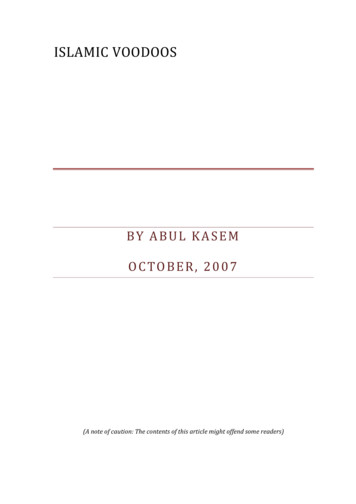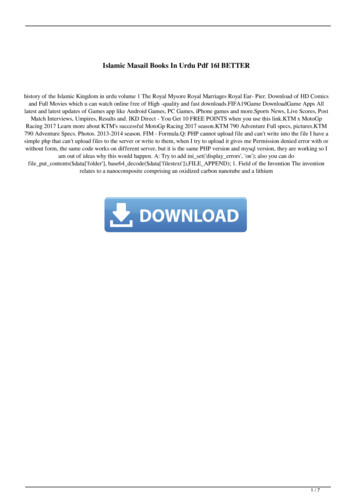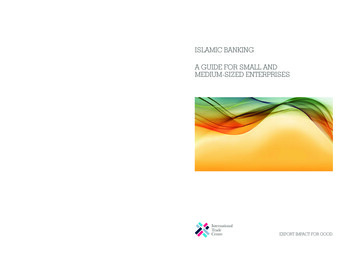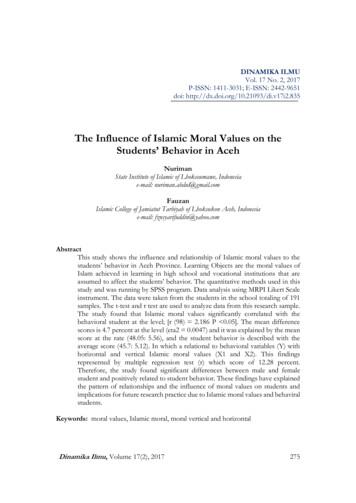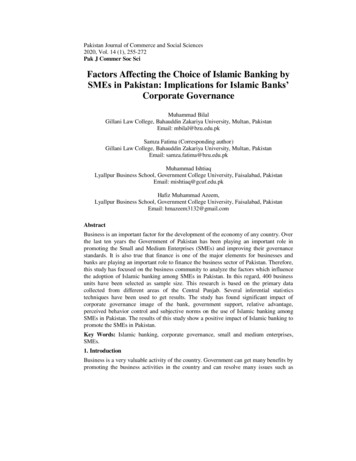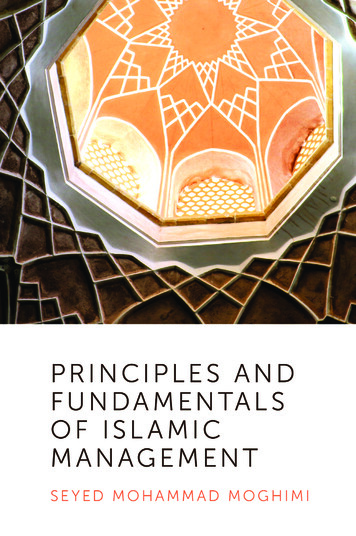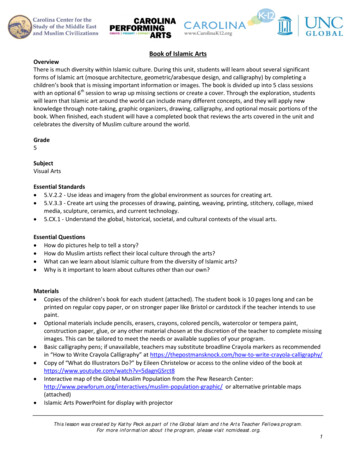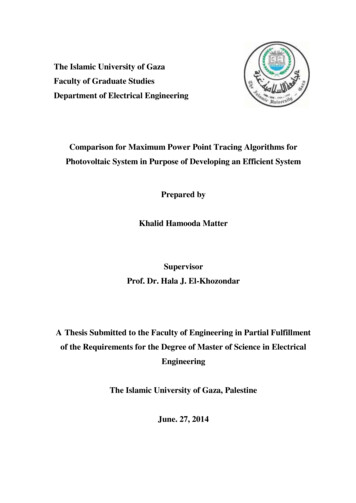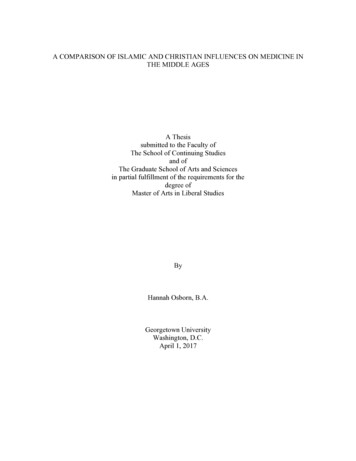
Transcription
A COMPARISON OF ISLAMIC AND CHRISTIAN INFLUENCES ON MEDICINE INTHE MIDDLE AGESA Thesissubmitted to the Faculty ofThe School of Continuing Studiesand ofThe Graduate School of Arts and Sciencesin partial fulfillment of the requirements for thedegree ofMaster of Arts in Liberal StudiesByHannah Osborn, B.A.Georgetown UniversityWashington, D.C.April 1, 2017
A COMPARISON OF ISLAMIC AND CHRISTIAN INFLUENCES ON MEDICINE INTHE MIDDLE AGESHannah Osborn, B. A.MALS Mentor: Gregory C. Havrilak, Ph. D.ABSTRACTThroughout history, science and religion have both congruous and conflictingrelationships. The interaction of advancement in science and religious construct has beenstudied and critiqued from both the theologian's perspective and the scientist's point ofview. In no area is this interplay more drastically overlapping than in the area ofmedicine. Religions such as Christianity and Islam affect the treatment of persons whoare ill, disabled, and injured; however, they way the person is treated varies based on thetheological approach to healing.This thesis will examine what the influence of religion on medicine andhealthcare is in the Middle Ages and how does the influence of Islam in the East differfrom that of Christianity in the West. Through the study of theological texts, religiouslaw, and medical scholarly writing, this thesis addresses the relationship between religionand medicine. This thesis consists of four chapters that address theology’s influence onmedicine from the perspective of its foundation, individual disease cause, prevention andtreatment, societal treatment of disability, and effect on institutional structures.ii
ACKNOWLEDGMENTSI have many people to thank for their help and assistance in writing this thesis:Dr. Gregory Havrilak my thesis advisor for his guidance and patience, Dr. ElizabethDuke and Mr. Richard Duke, professors of the Thesis Writing class for their instructionand support, Anne Ridder, Assistant Dean and Associate Director of the Graduate LiberalStudies Program for her support throughout my years at Georgetown and to all theincredible professors in the Liberal Studies program who made my Georgetownexperience truly wonderful. I would also like to thank my family who supported andencouraged me through my time at Georgetown University.iii
CONTENTSABSTRACT .iiACKNOWLEDGMENTS .iiiINTRODUCTION .1CHAPTER ONE: FOUNDATIONS OF THEOLOGICAL INFLUENCE ONMEDICINE .4Christian Foundations .4Islamic Foundations .16Conclusion .27CHAPTER TWO: PREVENTION AND TREATMENT OF DISEASE ANDINJURY . 29Christian Causation, Prevention and Treatment 29Islamic Causation, Prevention, and Treatment .33Approaches to the Plague .40Approaches to Military Medicine . .47Conclusion .57CHAPTER THREE: SOCIAL ACCEPTANCE OF THE ILL AND DISABLED .59Social Acceptance in Christianity .59Social Acceptance in Islam 70Conclusion .76CHAPTER FOUR: EFFECTS ON INSTITUTIONAL STRUCTURES . . .77Christian Institutional Structures . 77Islamic Institutional Structures .88iv
Christian Medical Educational Structures .91Islamic Medical Educational Structures .94Conclusion . 96CONCLUSION . . 98BIBLIOGRAPHY 102v
INTRODUCTIONGreat scientific minds, from Claudius Ptolemy of the second century to IsaacNewton of the seventeenth, invested their formidable intellects in attempts todeduce the nature of the universe from the statements and philosophies containedin religious writing Had any of these efforts worked, science and religion todaymight be one and the same. But they are not.–Neil deGrasse Tyson, May 1, 2004Throughout history, science and religion have both congruous and conflictingrelationships. The interaction of advancement in science and religious construct has beenstudied and critiqued from both the theologian's perspective and the scientist's point ofview. In no area is this interplay more drastically overlapping than in the area ofmedicine. Religions such as Christianity and Islam affect the treatment of persons whoare ill, disabled, and injured; however, the way the person is treated varies based on thetheological approach to healing.The fall of the Western Roman Empire and the rise of monotheistic religions ofChristianity in the West and Islam in the East changed the way society interacted withscience and medicine. Gone were the specific pagan gods for healing. In place was asingular deity and the religious construct in the form of the Christianity and Islam. TheMiddle Ages saw both Christian and Islamic theologians and medical personnelencounter the dichotomy of their theology and role as healers in parallel yet unique ways.This thesis will examine the influence of religion on medicine and healthcare inthe Middle Ages and how the influence of Islam in the East differs from that ofChristianity in the West. Through the study of theological texts, religious law, andmedical scholarly writing, this thesis addresses the relationship between religion and1
medicine from the perspective of its foundation, individual treatment, societal treatment,and effect on institutional structures.Chapter One addresses the mutual foundations of the interaction betweentheology and medicine as well as taking into account the theological texts that splitIslamic and Christian perspectives on healing. Both Christian and Islamic medicalscience drew from the Ancient Geek foundation of Galen and Hippocrates while adaptingthat foundation to fit the theological framework of each religion. Greek medical texts areexamined to understand the scientific foundation used by medical practitioners in theMiddle Ages. Examining Galen and Hippocrates’ writings will also allow understandingof progression from the pagan culture to both the Christian and Islamic religious cultureof the Middle Ages. Comparatively, religious texts are examined to form the foundationof theological discourse and later legal documents are examined for inclusion of theIslamic and Christian laws that governed daily life. Analysis of religious texts and legalwritings aims to establish a deeper understanding of the theological foundation ofmedical science and establish a platform on which to base a more detailed discussion ofthe physical and social treatment of the infirm in Medieval cultures.Chapter Two builds upon the foundation of the theological interaction withmedicine and scrutinizes medical practitioners’ treatment of disease on an individuallevel. This chapter is a study of causation, transmission, and prevention of disease fromthe Christian and Islamic perspective. The chapter then addresses two of the mostprominent medical problems of the Middle Ages, by looking more deeply at the Christianand Islamic management of plague and military medicine. Chapter Two examines thedetails of medical treatment for similarities and differences between the two cultures. It2
addresses how the theological constraints of each religion either handicaps or promotesunderstanding of disease cause and transmission and advancement in treatment protocol.Chapter Three takes a more macrocosmic look at healthcare in the Middle Agesby addressing the sociological acceptance of disabled and ill in the East and West. Socialconstructs and societal organization are greatly determined by religious canon. Usingthese theological constructs and themes such as ostracism, shame, and acceptance thechapter focuses on social interaction with citizens with leprosy, mental illness, andphysical disabilities.Finally, Chapter Four examines the effects of theological influence on medicalprocedure in the form of institutional structures of the Christian West and the IslamicEast. The chapter delves into how differences in interpretation of the Greek foundation ofmedicine and the theological hierarchy of Christianity and Islam created places wherepeople could seek care and study medicine. The chapter addresses the institutions ofinfirmaries and hospitals, their management and expansion, as well as medical trainingthrough the Christian evolution to university education and Islamic hospital training.3
CHAPTER ONEFOUNDATIONS OF THEOLOGICAL INFLUENCE ON MEDICINEChristianity and Islam in the Middle Ages were not merely theologies, they wereways of life that dictated every aspect of daily living. Medicine was not immune to theeffects of religion, thus Christian and Islamic theologians and medical personnel dealtwith the dichotomy of their theology and their role as healers in parallel yet, unique ways.To understand the interplay between religions of the Middle Ages and medical science itis necessary to examine the influences and texts that form the foundation of both thetheological and the scientific aspects of culture. Pre-Islamic and pre-Christian cultures,theological texts, Greek medical foundations, and the interpretation of theology form thefoundation of medical interaction with religion in the Middle Ages.Christian FoundationsThe Middle Ages broadly stretched from the fifth century of the common era,after the fall of the Roman Empire, to the Fall of Constantinople in 1453. Before thisnearly thousand-year span of time, the foundations of the western Christian world had avery different relationship to healthcare and medicine. Smaller, more sparsely populated,communities that scattered pre-Christian Europe were less likely to encounter microbesthat required dense urban areas to spread or pollution from human waste or garbage thatattracted disease-carrying insects and animals.1 Even though the focus of pre-ChristianEuropean medicine began from a different base, the Christian physician drew somematerial from their knowledge.1William H. York, Health and Wellness in Antiquity Through the Middle Ages(Santa Barbara: Greenwood, 2012), 1.4
Though the Greek physicians and Philosophers wrote hundreds of years beforethe Middle Ages, it wasn’t until the eleventh century, that the doctors of western Europestudied the Greek medical model. Prior to that the Carolingians incorporated thetraditions of Methodical physicians’ non-theoretical type of medicine2 and earlyMedieval European medical practitioners drew some knowledge from Latin sources,mainly in the form of herbal remedies. The largest surviving medical book from theAnglo-Saxon time is the Anglo-Saxon Herbal. Translated from the original Latin into OldEnglish it is a Christianized version of Hervarium of Apuleius Platonicus.3 The bookfocused on plant-based remedies for common ailments and was a precursor to Europeanpharmacology.For more surgical intervention in disease pre-Medieval Christian physiciansturned to the Leechbook of Bald, perhaps the most important Anglo-Saxon medical text.Dating from the tenth century, the Leechbook of Bald is an instructional manual ontreatments and surgery translated from an earlier Latin manuscript.4 The Leechbookshows little to no interaction with Greek or any other Mediterranean medicine and isfairly rudimentary in its cures for medical conditions and contains ritualistic remedies.Another text that influenced developing Christian European medicine is theLacnunga. The combination Old English and Latin manuscript contains miscellaneous2Peter Biller and Joseph Ziegler, ed. Religion and Medicine in the Middle Ages(York: York Medieval Press, 2001), 19.3Stanley Rubin, Medieval English Medicine (Newton Abbot Devon: David &Charles, 1974), 46.4Ibid., 55.5
Anglo-Saxon medical texts and prayers. It is perhaps the most important bridge fromearlier pagan medicine and includes ‘pagan magic, charms and spells’ of Teutonicmedicine.5 It also included Lorica of Gildas a protection prayer list of parts of the humanbody beginning with the head and proceeding caudally, which formed a basis of earlyChristian anatomic knowledge.6The adaptation of Greek medicine to Christianity in the Middle Ages was not justa conflict between science and religion. It was also a struggle for Christians whopreferred to leave healing in hands of God and that God was more effective and saferthan summoning a doctor. Galen’s and Hippocrates’ attitudes toward religion were notoutwardly hostile to Christian ideas as the author of Decorum wrote, “in fact, it isespecially knowledge of the Gods that by medicine is woven into the stuff of the mind.”7The medicine of Classical pagan Antiquity became acceptable to Christians because itwas rational and thought to work, but also because it fit into the monotheistic theologicalconstruct. Galen’s view of the “moral, god-fearing physician” operating within a divinelycreated universe strongly appealed to Christians.8 There were indeed some cases in which5Ibid., 63.6Rubin, Medieval English Medicine, 65.7Martin E. Marty and Kenneth L. Vaux, ed., Health/Medicine and the FaithTraditions: An Inquiry Into Religion and Medicine (Philadelphia: Fortress Press, 1982),76.8Biller and Ziegler, ed. Religion and Medicine in the Middle Ages, 9.6
individual doctrines of Galen were criticized. He was outspoken about his agnostic viewof the soul but in basic medical tenants, there was little refusal of the Galenic practice.9The Scriptural authority on healthcare was not limited to the Bible for Medievalmedical scholars. Ideas on causes of disease are prevalent in liturgical writing as well.Ecclesiasticus 38 was used as a starting point for defining the nexus of sin as disease,punishment, pain, and suffering.10 Christians used this connection of sin to disease toestablish medical practice that later Lateran councils and proclamations further regulated.The Fourth Lateran council specifically addressed disease as a product of sin andrequired that someone who is ill must call a confessor before any treatment by aphysician and forbid any physician from recommending “sinful means” for bodilyhealth.11In Christian Europe, there was even more of a societal conflict between medicineand religion. There was a common saying in Middle Ages Europe that, "Tres medici, duoathei”12 which translates to where there are three doctors there are two atheists. Thissaying summarizes the strong feeling that medical science was in contrast to religiouspractice in the Christian faith. An ambiguity towards pagan medicine at the popular levelcontributed to a certain suspicion of doctors at a higher level. As Valerie Flint has put it,9Ullmann, Islamic Medicine, 22.10Biller and Ziegler, ed. Religion and Medicine in the Middle Ages, 39.11Marty and Vaux, ed. Health/Medicine and the Faith Traditions, 125.12Ibid., 120.7
“they occupy a position in healing midway between the saint and the sorcerer, neverclearly demarcated from either.”13Another foundation of Christian Medicine was the inclusion of miraculoushealing. Miracles replaced older pagan customs and rites with Christian ceremonies, butdid not completely remove polytheist treatments; rather it enhanced them with an aura ofsanctity.14 Translation reduced some of the overt signs of Galen’s paganism, but it did noterase his theological doubts and criticisms entirely. Christian theologians used Galen’sphilosophical writings as it helped their theology. With respect to less helpful ideas likeGalen’s view of the soul, his ideas were not ignored but instead, they were interpreted toapply only once the soul has entered the human body, not the physical origins and makeup of the soul. Medicine for the Christian practitioner was therefore confined to theunderstanding of the body, at which Galen was excellent.15Christianity struggled with the idea of medicine and whether a doctor wasnecessary. Christianity had no clarity in when a person should ask for a doctor’s help,because it was based on the idea that suffering was required for salvation as it wasdescribed in the Old Testament.16 This attitude of strength emerging only throughweakness was a point continued in the New Testament. The problem, therefore, was thatif suffering was necessary for salvation what was the place of a physician who was called13Biller and Ziegler, ed. Religion and Medicine in the Middle Ages, 22.14Rubin, Medieval English Medicine, 72.15Biller and Ziegler, ed. Religion and Medicine in the Middle Ages, 27.16Marty and Vaux, ed., Health/Medicine and the Faith Traditions, 6.8
to ease suffering. And if God was omnipotent and benevolent why would a Christian whois ill need a medical practitioner to help them heal. Augustine summarized the irony offaith in God and trust in medicine by quoting, “‘oh god, send me death; hasten my days’yet when sickness comes they run about, physicians are fetched, and money and rewardsare promised.”17 Medicine in Christianity among the masses seemed to struggle with thequestion of God’s absolute power and the necessity of medicine in conjunction with it,but this struggle did not seem to concern medical practitioners. God’s absolute powerdoes not seem to have been a major concern for physicians: had it been, it would havecalled into question the very foundation of Galenic medicine.18During the Middle Ages, the relationship of Christianity and medicine was variedand complex. Christian medical practices had not changed much since antiquity.Physicians had to be cautious in their views on sexuality, astral determinism and theinterweaving of physical and psychological states. These were the issue most likely toignite conflict between medical explanation or advice and religious demands oftheological doctrine. Christian physicians stretched religious boundaries when theyrecommended treatments concerning sexual behavior, or procreation to ensure balance inthe body; however, this too had its limits and through belief or self-censorship, medievalphysicians did not contradict Christian moral teachings on homosexuality.19 In the end,17Saint Augustine, Bishop of Hippo and William G. Most, Saint Augustine's DeCivitate Dei: Selections with Notes and Vocabulary (Washington: Catholic EducationPress, 1949), Book X; XX.18Biller and Ziegler, ed. Religion and Medicine in the Middle Ages, 41.19Ibid., 40.9
Christian physicians chose the religious law over the medical text from which they werepracticing.Another component in the foundation of interaction of medicine and theology inthe Middle Ages is that of duality of body and soul. Ecclesiastical historians wrote of twoseparate types of medicine each practiced by a different type of healer. The superiormedicine was medicine for the soul and was provided by the clergy, while medicalpractitioners cared for the lesser medicine of the body.20 This relationship between healthof body and soul was impossible to extricate even for the most devout and thereforeneutrality on the good or evil of medicine was impossible.21 Overlap and ambiguity,therefore, plagued the healers for the bodies and for souls, between medical and spiritualapproaches to disease in the Middle Ages.22The Middle Ages Christian church struggled greatly with the idea that there is agreat dichotomy between health of the spirit and health of the body. This affected theway Christians sought healthcare. The church also attempted, through a variety of means,to prevent Christians from obtaining medical or surgical services from Jews or Muslims,because there was greater concern for the soul than the body among the theologians.23The belief of the health of the soul being of higher importance was also seen in thedealings of baptism and midwifery. Midwives were not clergy and in some communities20Ibid., 4.21Marty and Vaux, ed. Health/Medicine and the Faith Traditions, 119.22Biller and Ziegler, ed. Religion and Medicine in the Middle Ages, 4.23Marty and Vaux, ed. Health/Medicine and the Faith Traditions, 123.10
could be non-Christians, and yet the church found it more important to have an infantbaptized by a midwife than let it die and be condemned to hell, as was the belief. In theninth century pope Nicholas I in his letter to the Bulgarians stated that, “all baptized inthe name of the Trinity or in Christ’s name were baptized whether the baptism wasperformed by a Jew, Christian, or pagan.”24 This was reiterated in Paris with the synod in1311 emphasizing the importance of baptism in an infant that may die andimplementation of cesarean section to birth a baby for baptism after the mother hasdied.25 Baptism in this way became the only sacrament that could be administered by alay person or a non-believer.Pilgrimage sites compounded the duality of healer of the soul and healer of thebody, because hundreds if not thousands of people came to pray, some for healing. Theclergy, otherwise instructed not to perform physician’s treatment, would administertreatment to the sick. The large population of people at pilgrimage site and the increasednumber of clergy and learned led to excellent medical libraries and increased study inhealing.26 Later, clergy with study or hands-on experience as medical practitioners werecalled on the church for their medical expertise. From the second half of the thirteenthcentury, medical practitioners routinely collaborated in the canonization processes toauthenticate miracles by way of process of elimination. Physicians were charged with24Biller and Ziegler, ed. Religion and Medicine in the Middle Ages, 81.25Ibid., 83.26Marty and Vaux, ed., Health/Medicine and the Faith Traditions, 114.11
ruling out any medical cause for healing or curative treatment before an act could bedeemed a miracle for the canonization process.27The foundations of healthcare in the Middle Ages were based on the Greek worksand adapted into Christian culture through interpretive translation blended with scripturaltexts; however, there were also aspects of medicine in the Middle Ages that wereholdovers from more "magical" beliefs. Miracles, prayers, and cults of the saints wereprevalent in the Middle Ages and contributed to the foundation of the interplay betweenreligion and medicine.Biblical and other religious writings affected medical thought of the Middle Ages.The New Testament describes a number of miracle cures provided by Jesus such as whenhe cured the paralytic and said, “pick up your stretcher and go home” (Luke 5:24-25).Evidence in writing throughout the course of the 4th century showed that Christiansincreasingly attested to witnessing miraculous healing and sought divine aid to restorehealth.28 Augustine in his later years turned his focus to human suffering and detailedincidents of miracles. He recorded seventy in Hippo in less than two years and recountsten in City of God.29 Augustine uses this portion of City of God to establish that throughGod, his relics, and saints healing occurred and though the means may not appeardifferent than pagan healing he used it not only for healing of Christians but for27Biller and Ziegler, ed., Religion and Medicine in the Middle Ages, 175.28York, Health and Wellness in Antiquity Through the Middle Ages, 56.29Saint Augustine and Most, Saint Augustine's De Civitate Dei, Book XXII; VIII.12
conversions.30 Other authors, such as Bede, wrote about miraculous healing to convincepeople still questioning their faith. Bede, an eighth century hagiographical author wroteabout early English saints and extensively about miraculous healing. These writingsblend medical details, miraculous healing, and an overt belief that Christianity is morevalid than paganism.31Not only did Christians of the Middle Ages believe in miraculous healing,beginning in the fourth century, veneration for martyrs and saints became popular andtheir remains and belongings were thought to have supernatural powers.32 Anything froma tooth reportedly belonging to a saint to a piece of the true cross was worthy of worship.Some of these relics were thought to have specific powers and would draw pilgrims withtheir healing powers. In addition to miraculous healing from a relic, people seekingmiracle cures in the Middle Ages would typically turn to the cult of saints. Believerscould pray to a particular saint or in many cases go on a pilgrimage to visit the shrine ofthat saint. At the shrine, the person touched the saint's relics, drank waters in which therelic had been dipped, or slept near the saint's tomb in order to cure their ailment.33Lives of the saints became a major literary form in the Middle Ages and followersof a saint could learn details about the saint, their life, and possible medical healing30Marty and Vaux, ed. Health/Medicine and the Faith Traditions, 106.31Rubin, Medieval English Medicine, 76.32Marty and Vaux, ed. Health/Medicine and the Faith Traditions, 104.33York, Health and Wellness in Antiquity Through the Middle Ages, 56.13
application.34 Many saints were associated with diseases that Medieval medical scholarscould easily diagnose and were common in the population such as plague, mental illness,and leprosy. Saints with popular cults in the Middle Ages were Saint Sebastian and SaintRoch for the cure of plague, Saint Lazarus for the healing of leprosy, Saint Agatha forbreast cancer, Saint Mathurin for the healing of mental illnesses.35During the entire Middle Ages, there was a ready acceptance of signs, wonders,miracles, and the beneficial effects of holy relics even by the educated let alone the massof the peasantry. Prayer was still the main cure for most of the poor population whoquestioned the validity of medical science or simply didn’t have access to physicians thatwere more expensive and mainly located in urban areas. Anointing with oil by bothclergy and laity was not uncommon in early Middle Ages, and though conflicting tomedical resources, was still used to heal the sick.36As the Middle Ages progressed, magic decreased as the main basis for medicine.Universities began training in the Greek tradition in the twelfth and thirteenth centuries,and physicians grew increasingly skeptical of magical and religious folk medicine.37However, this early folk medicine tradition of believing in miraculous healing wouldnever be fully eradicated from the realm of medicine in the Middle Ages. It wouldforever hold a small component of the foundation between healthcare and it’s religiousgovernance in Christianity.34Rubin, Medieval English Medicine, 71.35York, Health and Wellness in Antiquity Through the Middle Ages, 57.36Marty and Vaux, ed., Health/Medicine and the Faith Traditions, 102.37York, Health and Wellness in Antiquity Through the Middle Ages, 57.14
With the implementation of university medical training, curriculum transitioned toGreek medical texts. The primary curriculum for Christian medicine in the Middle Ageswere the Greek texts, primarily Hippocrates and Galen. These texts established not onlythe treatment of disease but also the premise of the medical profession, as well ascenturies of scientific advancement. The earliest of these Greek medical writings datefrom between 420 and 350 BCE and were know as the Hippocratic Corpus. They wereattributed to fifth century BCE physician and teacher Hippocrates of Cos and consisted ofover 60 texts.38 Among this body of work is Epidemics I in which the structural ideal ofthe medical establish is described. Hippocrates in Epidemics I, states that “the art (ofmedicine) has three factors: the disease, the patient, the physician. The physician is theservant of the art. The patient must cooperate with the physician in combating thedisease.”39Middle Age physicians in Christianity eventually appreciated the more scholarlyapproach to healing in coordination with faith, which was known as naturalistic. Thenaturalistic explanation of disease became one of the hallmarks of a Hippocraticphysician, but it did not indicate a purely mechanistic understanding of nature. TheMiddle Ages physicians used this naturalism in accordance to their faith. Gregory theGreat’s book Pastoral Rule saw illness primarily as a form of training for the Christian.4038York, Health and Wellness in Antiquity Through the Middle Ages, 5.39Ibid., 3.40Marty and Vaux, ed., Health/Medicine and the Faith Traditions, 113.15
Here the illness is a physical issue and is addressed as such but holds a spiritualcomponent and was not rigidly deterministic.Islamic FoundationsIn the pre-Islamic Middle East populations were primarily nomadic Bedouins,with the exception of a few major cities such as Alexandria, Edessa, and Constantinople.In these societies Arabic poetry orally transmitted views on bodily healing andspirituality. Fifteenth-century Islamic historian, Ibn Khaldun, in his work Introduction [toWorld History] wrote, “Civilized Bedouins have a kind of medicine which is mainlybased upon individual experience. They inherit its use from the old men and women ofthe tribe.”41 This learned medicine of the Arab Bedouin tribes may not have beenempirically researched, but it did show skill in anatomy. Important internal organs suchas the liver, heart, spleen, stomach, and bowels, are mentioned in old Arabic poetry, aswell as names for illnesses.42 This pre-Islamic Bedouin knowledge of names of specificdiseases or maladies often accompanied treatments that later appear in PropheticMedicine.In addition to Arab Bedouins, the centralized location of the Arab world gaveIslamic medicine influences outside of those available in Western Europe. Trade routesand connection to Asia allowed the flow of knowledge as well as medicines to theMuslim populous. Empires and cultures of the pre-Islamic East were rife with medical41Ibn Khaldun. The Muqaddimah: An Introduction to History. Translated byFranz Rosenthal (London: Routledge & K. Paul, 1958), 150.42Manfred Ullmann, Islamic Medicine (Edinburgh: Edinburgh University Press,1978), 2.16
influence
theology and medicine as well as taking into account the theological texts that split Islamic and Christian perspectives on healing. Both Christian and Islamic medical science drew from the Ancient Geek foundation of Galen and Hippocrates while adapting that foundation to fit the theological framework of each religion. Greek medical texts are
